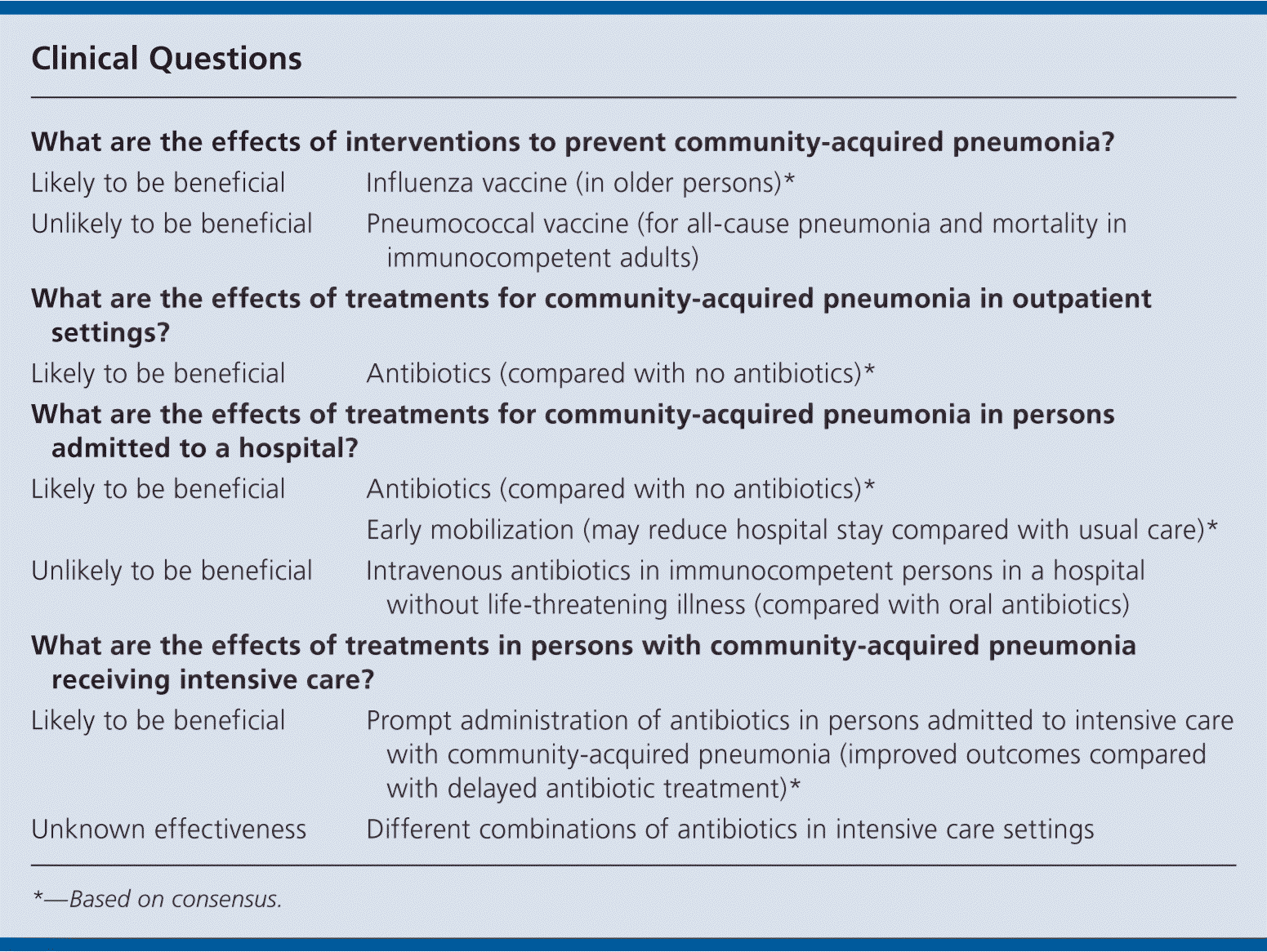
Am Fam Physician. 2011;84(2):218-219
Author disclosure: Mark Loeb has received research grants from Bayer and Aventis, and has attended conferences sponsored by Janssen-Ortho and Aventis.
In the northern hemisphere, about 12 out of 1,000 persons per year (on average) contract pneumonia while living in the community, with most cases caused by Streptococcus pneumoniae.
Persons at greatest risk include those at the extremes of age, smokers, those who are alcohol-dependent, and those with lung or heart disease or immunosuppression.
Mortality ranges from about 5 to 35 percent, depending on severity of disease, with a worse prognosis in older persons, men, and persons with chronic diseases.
Deaths from influenza are usually caused by pneumonia. Influenza vaccine reduces the risk of clinical influenza, and may reduce the risk of pneumonia and mortality in older persons.
Pneumococcal vaccine is unlikely to reduce all-cause pneumonia or mortality in immunocompetent adults, but may reduce pneumococcal pneumonia in this group.
Antibiotics lead to clinical cure in at least 80 percent of persons with pneumonia being treated in the community or hospital, although no one regimen has been shown to be superior to the others in either setting.
Early mobilization may reduce hospital stay compared with usual care in persons being treated with antibiotics.
Intravenous antibiotics have not been shown to improve clinical cure rates or survival compared with oral antibiotics in persons treated in the hospital for nonsevere, community-acquired pneumonia.
Prompt administration of antibiotics may improve survival compared with delayed treatment in persons receiving intensive care for community-acquired pneumonia, although we found few studies.
We do not know which is the optimum antibiotic regimen to use in these persons.

| What are the effects of interventions to prevent community-acquired pneumonia? | |
| Likely to be beneficial | Influenza vaccine (in older persons)* |
| Unlikely to be beneficial | Pneumococcal vaccine (for all-cause pneumonia and mortality in immunocompetent adults) |
| What are the effects of treatments for community-acquired pneumonia in outpatient settings? | |
| Likely to be beneficial | Antibiotics (compared with no antibiotics)* |
| What are the effects of treatments for community-acquired pneumonia in persons admitted to a hospital? | |
| Likely to be beneficial | Antibiotics (compared with no antibiotics)* |
| Early mobilization (may reduce hospital stay compared with usual care)* | |
| Unlikely to be beneficial | Intravenous antibiotics in immunocompetent persons in a hospital without life-threatening illness (compared with oral antibiotics) |
| What are the effects of treatments in persons with community-acquired pneumonia receiving intensive care? | |
| Likely to be beneficial | Prompt administration of antibiotics in persons admitted to intensive care with community-acquired pneumonia (improved outcomes compared with delayed antibiotic treatment)* |
| Unknown effectiveness | Different combinations of antibiotics in intensive care settings |
Definition
Community-acquired pneumonia is pneumonia contracted in the community rather than in a hospital. It is defined by clinical symptoms (e.g., cough, sputum production, pleuritic chest pain) and signs (e.g., fever, tachypnea, rales), with radiologic confirmation.
Incidence and Prevalence
In the northern hemisphere, community-acquired pneumonia affects about 12 out of 1,000 persons per year, particularly during winter, and in persons at the extremes of age (annual incidence in persons younger than one year: 30 to 50 out of 1,000; 15 to 45 years of age: 1 to 5 out of 1,000; 60 to 70 years of age: 10 to 20 out of 1,000; 71 to 85 years of age: 50 out of 1,000).
Etiology
More than 100 microorganisms have been implicated in community-acquired pneumonia, but most cases are caused by S. pneumoniae. Case-control study data suggest that smoking is probably an important risk factor. One large cohort study conducted in Finland (4,175 persons at least 60 years of age) suggested that risk factors for pneumonia in older persons include alcoholism (relative risk [RR] = 9.0; 95% confidence interval [CI], 5.1 to 16.2), bronchial asthma (RR = 4.2; 95% CI, 3.3 to 5.4), immunosuppression (RR = 3.1; 95% CI, 1.9 to 5.1), lung disease (RR = 3.0; 95% CI, 2.3 to 3.9), heart disease (RR = 1.9; 95% CI, 1.7 to 2.3), institutionalization (RR = 1.8; 95% CI, 1.4 to 2.4), and increasing age (age at least 70 years versus 60 to 69 years; RR = 1.5; 95% CI, 1.3 to 1.7).
Prognosis
Severity varies from mild to life-threatening illness within days of symptom onset. A prospective cohort study of more than 14,000 persons found that older age was an extremely important factor in determining prognosis. One systematic review of prognosis studies for community-acquired pneumonia (search date, 1995; 33,148 persons) found overall mortality to be 13.7 percent, ranging from 5.1 percent for ambulatory persons to 36.5 percent for persons who required intensive care. Prognostic factors significantly associated with mortality were: male sex (odds ratio [OR] = 1.3; 95% CI, 1.2 to 1.4), absence of pleuritic chest pain (OR = 2.00; 95% CI, 1.25 to 3.30), hypothermia (OR = 5.0; 95% CI, 2.4 to 10.4), systolic hypotension (OR = 4.8; 95% CI, 2.8 to 8.3), tachypnea (OR = 2.9; 95% CI, 1.7 to 4.9), diabetes mellitus (OR = 1.3; 95% CI, 1.1 to 1.5), neoplastic disease (OR = 2.8; 95% CI, 2.4 to 3.1), neurologic disease (OR = 4.6; 95% CI, 2.3 to 8.9), bacteremia (OR = 2.8; 95% CI, 2.3 to 3.6), leukopenia (OR = 2.5; 95% CI, 1.6 to 3.7), and multilobar radiographic pulmonary infiltrates (OR = 3.1; 95% CI, 1.9 to 5.1).
